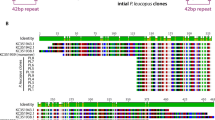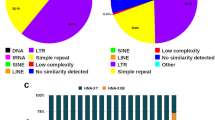Summary
The clone designated hMF #1 represents a clustered DNA family, located on chromosome 1, consisting of tandem arrays displaying a monomeric length of 40 bp and a repetition frequency of approximately 7×103 copies per haploid genome. The sequence hMF #1 reveals multiple restriction fragment length polymorphisms (RFLPs) when human genomic DNA is digested with a variety of 4–6-bp recognition sequence restriction enzymes (i.e., Taq I, Eco RI, Pst I, etc.). When hamster and mouse genomic DNA was digested and analyzed, no cross-species homology could be observed. Further investigation revealed considerable hybridization in the higher primates (chimpanzee, gorilla, and orangutan) as well as some monkey species.
The evolutionary relationship of this repetitive DNA sequence, found in humans, to that of other primates was explored using two hybridization methods: DNA dot blot to establish copy number and Southern DNA analysis to examine the complexity of the RFLPs. Homology to the hMF #1 sequence was found throughout the suborder Anthropoidea in 14 ape and New and Old World monkey species. However the sequence was absent in one species of the suborder Prosimii. Several discrepancies between “established” evolutionary relationships and those predicted by hMF #1 exist, which suggests that repetitive elements of this type are not reliable indicators of phylogenetic branching patterns. The phenomenon of marked diversity between sequence homologies and copy numbers of dispersed repetitive DNA of closely related species has been observed inDrosophila mice,Galago, and higher primates. We report here a similar phenomenon for a clustered repeat that may have originated at an early stage of primate evolution.
Similar content being viewed by others
References
Adeniyi-Jones S, Zasloff M (1985) Transcription, processing and nuclear transport of a B1 Alu RNA species complementary to an intron of the murine α-fetoprotein gene. Nature 317:81–84
Bell GI, Selby MJ, Rutter WJ (1982) The highly polymorphic region near the human insulin gene is composed of simple tandemly repeating sequences. Nature 295:31–35
Bonner TI, Brenner DJ, Neufeld BR, Britten RJ (1973) Reduction in the rate of DNA reassociation by sequence divergence. J Mol Biol 88:123–135
Britten RJ, Davidson EH (1969) Gene regulation for higher cells: a theory. Science 165:349–357
Buroker N, Bestwick R, Haight G, Magenis RE, Litt M (1987) A hypervariable repeated sequence on human chromosome 1p36. Hum Genet 77:175–181
Burton FH, Loeb DD, Voliva, CF, Martin SL, Edgell MH, Hutchison CA III (1986) Conservation throughout Mammalia and extensive protein-encoding capacity of the highly repeated DNA long interspersed sequence one. J Mol Biol 187:291–304
Clemens MJ (1987) A potential role for RNA transcribed from B2 repeats in the regulation of mRNA stability. Cell 49:157–158
Daniels GR, Deininger PL (1985) Repeat sequence families derived from mammalian tRNA genes. Nature 317:819–822
Davidson EH, Jacobs HT, Britten RJ (1983) Very short repeats and coordinate induction of genes. Nature 302:468–470
Deininger PL, Daniels GR (1986) The recent evolution of mammalian repetitive DNA elements. Trends Genet 2:76–80
Doolittle WF, Sapienza C (1980) Selfish genes, the phenotype paradigm and genome evolution. Nature 284:601–603
Dudley JP (1987) Discrete high molecular weight RNA transcribed from the long interspersed repetitive element L1Md. Nucleic Acids Res 15:2581–2592
Epstein ND, Karlsson S, O'Brien S, Modi W, Moulton A, Neinhuis AW (1987) A new moderately repetitive DNA sequence family of novel organization. Nucleic Acids Res 15:2327–2341
Feinberg AP, Vogelstein B (1983) A technique for radiolabelling DNA restriction endonuclease fragments to high specific activity. Anal Biochem 132:6–13
Haslem DB, Hoar DI (1984) Stepping across chromosomes using a repetitive DNA probe. Am J Hum Genet 36:A414
Hastie N (1985) Middle repetitive DNA: amplification, homogeneity and mobility. Trends Genet 1:37
Hoar DI, Tynan KM, MDSC 717 Class (1987) Does Lambda reject selected repeat sequences? Am J Hum Genet 41:A219
Jagadeeswaran P, Forget BG, Weissman SM (1981) Short interspersed repetitive DNA elements in eucaryotes: transposable DNA elements generated by reverse transcription of RNA Pol III transcripts? Cell 26:141–142
Jeffreys AJ, Wilson V, Thein SL (1985) Hypervariable “minisatellite” regions in human DNA. Nature 314:67–73
Jeffreys AJ, Royle NJ, Wilson V, Wong Z (1988) Spontaneous mutation rates to new length alleles at tandem-repetitive hypervariable loci in human DNA. Nature 332:278–280
Lewin B (1980) Gene expression, ed. 2. Eucaryotic chromosomes. Wiley, New York
Madisen L, Hoar DI, Holroyd CD, Crisp M, Hodes ME (1987) DNA banking: the effects of storage of blood and isolated DNA on the integrity of DNA. Am J Med Genet 27:379–390
Maniatis T (1982) Molecular cloning (a laboratory manual). Cold Spring Harbor Laboratory, Cold Spring Harbor NY
Marashi F, Prokopp K, Stein J, Stein G (1984) Evidence for a human histone gene cluster containing H2B and H2A pseudogenes. Proc Natl Acad Sci USA 81:1936–1940
Nakamura Y, Leppert M, O'Connell P, Wolff R, Holm T, Culver M, Martin C, Fujimoto E, Hoff M, Kumlin E, White R (1987a) Variable number of tandem repeat VNTR markers for human gene mapping. Science 235:1616–1622
Nakamura Y, Julier C, Wolff R, Holm T, O'Connell P, Leppert M, White R (1987b) Characterization of a human minisatellite sequence. Nucleic Acids Res 15:2537–2547
Needleman SB, Wunsch CD (1970) A general method applicable to the search for similarities in the amino acid sequence of two proteins. J Mol Biol 48:443–453
Nei M (1975) Molecular population genetics and evolution. Frontiers of Biol Series. North Holland Publishing
Orgel LE, Crick FHC (1980) Selfish DNA: the ultimate parasite. Nature 284:604–607
Paolella G, Lucerno AM, Murphy MH, Baralle FE (1983) The Alu family repeat promoter has a tRNA-like bi-partite structure. EMBO J 2:691–696
Pfeffer D, Mierendorf R (1986) Direct sequencing of pGem™ plasmid: Klenow vs. reverse transcriptase. Promega Notes 5
Rose MR, Doolittle WF (1983) Molecular biological mechanisms of speciation. Science 220:157–162
Sanger F, Nicklen S, Coulson AR (1977) DNA sequencing with chain-terminating inhibitors. Proc Natl Acad Sci USA 74: 5463–5467
Sawada I, Schmid CW, Deka N, Paulson KE, Willard C (1986) Repetitive human DNA sequences. Cold Spring Harbor Symp Quant Biol 51:470–477
Schwindinger WF, Warner JR (1984) DNA sequence analysis on the IBM-PC. Nucleic Acids Res 12:601–604
Sierra F, Lichtler A, Marashi JR (1984) DNA sequence analysis on the IBM-PC. Nucleic Acids Res 12:601–604
Sierra F, Lichtler A, Marashi F, Rickles R, Van Dyke T, Clark S, Wells J, Stein G, Stein J (1982) Organization of human histone genes. Proc Natl Acad Sci USA 79:1795–1799
Smith GP (1986) Unequal crossover and the evolution of multigene families. Cold Spring Harbor Symp Quant Biol 51: 507–513
Tynan KM, Hoar DI (1986). A human low copy repetitive probe (hMF #1) and its potential for estimating genetic and evolutionary distance. 7th International Congress of Human Genetics, Berlin, Abstracts, p 674
Tynan KM, Hoar DI (1987a) A tandemly repeating DNA sequence for molecular fingerprinting in the human genome. Am J Huma Genet 41:A242
Tynan KM, Hoar DI (1987b) Transcription in a tissue specific pattern of a low copy repetitive sequence. Genet Soc Can Bull 18:HAG-3
Tynan KM, Dimnik L, Starozik D, Hoar DI (1986) Definition of a new probe (hMF #1) for human molecular fingerprinting and zygosity testing. Gen Soc Can Bull 17:PGH-1
Tynan KM, Hoar DI (1988) Inheritance of a hypervariable repeated sequence located on chromosome, 1 among different ethnic populations. Genome, 30:369 (abstract)
Ullu E, Tschudi C (1984) Alu sequences are processed 7SL RNA genes. Nature 312:171–172
Van Arsdell SW, Weiner AM (1984) Human genes for U2 small nuclear RNA are tandemly repeated. Mol Cell Biol 4:492–499
Wahl GM, Stern M, Stark R (1979) Efficient transfer of large DNA fragments from agarose gels to diazobenzyloxymethylpaper and rapid hybridization by using dextran sulphate. Proc Natl Acad Sci USA 79:3683–3687
Walsh JB (1987) Sequence-dependent gene conversion: can duplicated genes diverge fast enough to escape conversion? Genetics 117:543–557
Wellauer PK, David IB (1979) Isolation and sequence organization of human ribosomal DNA. J Mol Biol 128:289–303
Young KE, Willard HF, Smith KD (1981) Molecular and chromosomal organization and analysis of DNA methylation of the human Y chromosome-specific 2.1 kb HaeIII DNA fragment. Am J Hum Genet 33:60A
Author information
Authors and Affiliations
Rights and permissions
About this article
Cite this article
Tynan, K.M., Hoar, D.I. Primate evolution of a human chromosome 1 hypervariable repetitive element. J Mol Evol 28, 212–219 (1989). https://doi.org/10.1007/BF02102478
Received:
Revised:
Issue Date:
DOI: https://doi.org/10.1007/BF02102478




